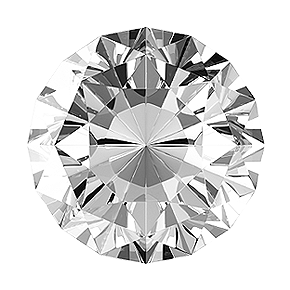When we normally look at diamonds, it’s fairly easy to tell which one is a better quality: the one that sparkles the most of course! But what factors contribute to the quality and beauty of the diamond that we are buying? What is it exactly that we are paying for? It’s the four Cs of Diamonds: cut, colour, clarity, and carat. 
Cut
The sparkle that we all want from a good diamond mostly comes from the way that the diamond is cut. The lines, angles, and proportions of the diamond determine the amount of light that is reflected in it. The higher the quality of the cut, the higher the quality and cost of the diamond. The cut affects the sparkle of a diamond in 3 main ways:
Brilliance – The total brightness created on the surface and inside of the diamond from light reflections
Fire – flashes of color seen within the diamond due to the refraction of white light into the various colors of the visible light spectrum
Scintillation – the sparkle of a diamond when you move it around
Each diamond has an optimal cut based on its size in which the most light is reflected. If you cut deeper or shallower than this level, then the sparkle is compromised.
Colour
While diamonds can come in lots of fancy colours–like yellow, pink, and blue– “colour” refers to white diamonds, which are graded on a scale of D (colorless) to Z (light color). The clearer a diamond is, the more expensive it is. So, a diamond with a grading of ‘D’ will be more expensive than one that’s graded ‘F’, even though the grades of ‘D’, ‘E’ and ‘F’ cannot be told apart by the untrained eye. Knowing the colour of the diamond can be useful in making a decision. For example, the colour of a diamond is much easier to see in a larger diamond, which can make it easier to select the right grade according to the size of the diamond when you are buying jewellery.

Clarity
Diamonds, like any gemstone, can have small imperfections in them. These are called “inclusions” if they are inside the diamonds, or “blemishes” if they are on the surface. The clarity of a diamond refers to the level of impurities inside the diamond. Since these impurities interfere with the movement of light through the diamond, the more the impurities, the less the sparkle. The grading scale goes from “flawless” (FL)–which is a diamond whose impurities can only be seen by a skilled grader under 10x magnification–to “included”, which is a diamond whose inclusions can be seen with the naked eye.
Carat Weight
A diamond’s “carat” (ct.)–not “karat” which refers to the purity of gold–is a measure of how much a diamond weighs. One carat is 0.2 grams. Contrary to popular belief, carat is not a measure of size, though size and weight are related; that’s why a higher carat diamond is a larger one. Since it’s much harder to find a larger diamond in nature, a higher carat also symbolizes the rarity of a diamond. In terms of price, the cost of a diamond rises exponentially the bigger it gets. This is because it can be easy to see colour and inclusion imperfections in a larger diamond, so buyers will want a higher quality diamond.

We at Karim Jewellers, using the principles that we’ve simplified above, will always strive to offer you the best advice when it comes to buying diamond jewellery. We always offer certified, high-quality diamonds, so you can shop with confidence. If you’d like more information, feel free to call us or come into our shop anytime, and we’ll be happy to help.